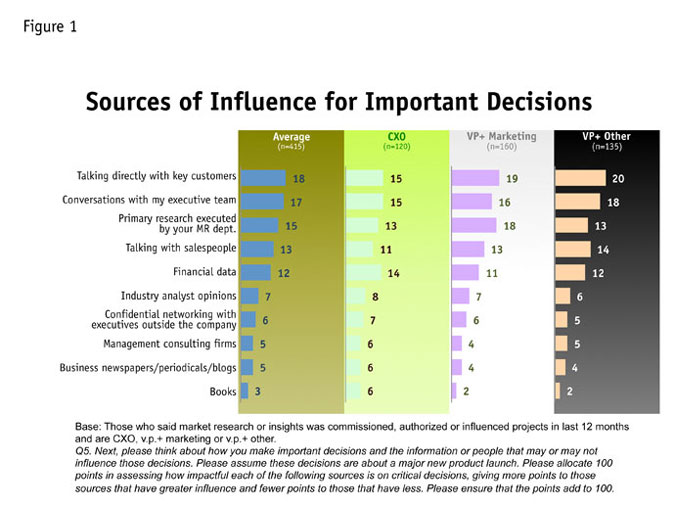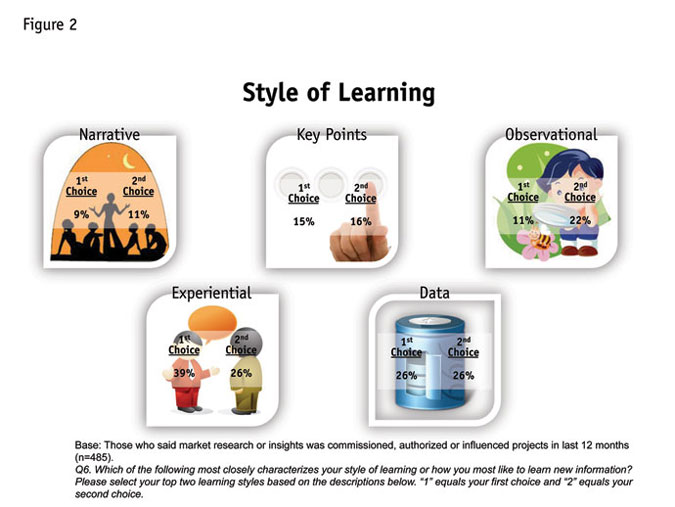We have our marching orders
Editor's note: Brett Hagins is senior partner at Research Innovation and ROI, Plano, Texas. Melanie Courtright is vice president of research services at Research Now, Plano, Texas.
In some companies, marketing research has descended into commodity status because of a failure to explicitly demonstrate its contribution to business outcomes. As researchers we know the value of what we do but if senior management is not able to see the return on their research expenditures, it is difficult for them to view research as an investment and in fact more likely that they will view it as a sunk cost.
To help develop strategies for raising the profile of research among C-level executives, Research Innovation and ROI, Plano, Texas, partnered with Plano-based Research Now to execute a study on senior executives’ perceptions of the research function. We targeted C-suite executives (including CEOs, CMOs, CIOs, CFOs, etc.), vice presidents and directors of marketing (executive, senior, etc.) and vice presidents of other functions who had engaged in at least one research project in the last 12 months through their corporate research department. Respondents were required to work in companies with $250 million in revenue or greater. Approximately 60 percent of respondents had commissioned three or more research projects in the last 12 months and about two-thirds came from organizations with revenue of $1 billion or more. Despite the difficulty of reaching such a targeted group of senior executives, Research Now provided over 450 completed surveys to meet the sample quota for this study.
Biggest impact
Executives were asked on an unaided basis, “What is the biggest impact your research department has had on your business that you can remember?” Many were not able to articulate a specific impact but some of the most inspiring answers include:
Increase sales/profit/retention/market share
“Increased sales by 12 percent.”
“Provided research to change our packaging color, which increased sales by 10 percent.”
“Advanced IT services by investigating the offerings of competitors. Increased server space led to increased consumer traffic, which ultimately drove profits.”
“Research department identified new customers in existing markets ... increasing sales and profit.”
“Created several new revenue streams.”
“Provided competitive insights to help win deals.”
“Increased retention.”
“Led us to implement a new pricing strategy that increased market share and revenues.”
“Increased product sales compared to prior year by 22 percent and decreased costs by 9 percent.”
“Thanks to the work of the department, in the past year, our profit increased by 20 percent.”
“Creating a warranty program. Created additional revenue without adding additional employee costs.”
“Development and launch of a new product in less than nine months, which led to significantly increased market share and sales.”
Product development and positioning
“Enabled the company to introduce a new product to Asia-Pac and provided leads for all the necessary groundwork ... and accurately forecasted revenue over three years.”
“Created a completely innovative product that will be a game-changer for the company.”
“Helped to successfully reposition a mature product, resulting in a reinvigorated and highly effective marketing communications program.”
Halted/stopped unprofitable programs/reduced costs
“Stopped us from pursuing a product line development which would have turned out very negatively from a financial point of view.”
“Accurately evaluated a product opportunity that kept us from spending a lot of money that was not needed.”
“[Facilitated] expansion ... which market and what strategy.”
“Discovered possible drilling conflicts before work commenced, therefore saving possible issues with clients and costs.”
“Kept us from making a bad acquisition.”
“Were able to cut down on cost by analyzing why people were calling our customer service line and coming up with ways to prevent those calls.”
Identified product/market/
opportunities
“Moving the product selection to an arena not previously considered. Confronted a market leader and gained significant market share.”
“Strategy to enter China market.”
“Our research department was extremely helpful in uncovering new, formerly untapped, customers.”
“Realizing the clients that were not being serviced in a particularly lucrative marketplace. Once identified, made impressive inroads to increase market share.”
“Uncovered new international markets for our product.”
“Identified market opportunity/gap and led product development to build what previously didn’t exist.”
“Product portfolio planning. Identifying trends that led us to pursue a highly successful product option.”
“Research enabled decision to move forward with a new business.”
Business-relevant outcomes
As the above responses indicate, research is, in fact, delivering a range of business-relevant outcomes for the companies that are commissioning it. But if profitable end-results aren’t enough to raise research’s profile, what else can be done? To find out, we asked the executives this question: “What do you think is the single most important thing research can do to increase status and visibility in your organization?”
Increase knowledge of/integration with financials
“Be more business/financial-oriented.”
“They simply need to better understand the financial impacts and economics of our sales, marketing and new product revenue. We need to provide them with more economics instruction from our finance department.”
“Tie research to internal revenue figures and lifetime customer value metrics.”
“If they knew the business better; sometimes the results don’t pass the smell test.”
“Bring a business case to the presentation to let us know what it is you are recommending.”
Get in front of the business
“Proactively address business issues.”
“Become more educated in the emerging segments of digital space instead of continued focus on the same things year after year.”
“Use research to drive ideas.”
“Anticipate needed research and better understand business problems.”
“Bring new things to the table. ‘Hey I saw this’ or ‘This is an emerging trend.’ Be a beacon for the business.”
“Lead the business.”
“Actionable recommendations.”
“New ideas and avenues for revenue increases.”
“Analyze market trends and suggest strategic offerings/product positioning AHEAD of market developments.”
“Be proactive in helping us figure out where we could benefit from research.”
“Predict the future.”
“Continue to tie research objectives to the strategy and highest priorities of the organization – get ‘in front’ of the organization.”
“Lead overall long-range planning efforts.”
Improved reporting structure
“The head of the research department has to be in a higher position. That could help them to be partners in the decision-making process rather than just a service.”
“Cross-training – career path w/experience in NPD and sales.”
“Have individual with research background elevated or brought in to executive leadership team.”
“Generate more champions on the board of directors.”
More internal marketing of
research/PR
“They need to do more internal marketing. They tend to allow the other departments who use their output to take the lead and therefore they (the other department) gains the status. Also, they tend to react rather then lead in some situations.”
“Show that all followed recommendations have become a success.”
“Be more vocal about impact of research.”
“Improve ‘in-house’ relationships.”
“Follow up on decisions to show results of making or not making the decision to proceed.”
“Take credit as business owners for contributions to the business.”
“Be more verbal on accomplishments/influences.”
Makes the difference
Each of these suggestions is critical. The reporting structure often influences whether research is engaged in top-level strategy decisions or whether it is engaged tactically after more strategic questions are already decided. Integrating research with the financials makes the difference between research being one of many inputs in the decision-making process and research driving the organization. Too often, research provides lagging indicators rather than leading ones. Leading the business necessitates using the research as a catalyst to drive consensus among different constituents and convergence among different influences in decision-making.
Figure 1 summarizes what we found when we asked executives to allocate 100 points to different sources of influence on their decision-making process.

Does not mesh well
Researchers are trained to strive for precision and rigor but a methodologically perfect research study is worth little if it does not mesh well with how executives want to learn new information. We asked executives to self-classify into one of five primary and secondary learning styles.
Key points: I prefer to have the information summarized into a few bullet points.
Narrative: I like to learn new insights through a narrative or story on the customer mind-set.
Observational: I prefer to learn from a visual exposition of consumer experiences such as pictures and videos or observing them in their natural environment.
Experiential: I prefer to learn by interacting directly with consumers, customers or prospects to discuss their underlying motivations.
Data: I prefer to learn by seeing the quantitative data that leads to new insights or conclusions.
As shown in Figure 2, the top learning style, experiential, suggests that research needs to facilitate direct contact between senior management and carefully-chosen respondents who personify the insights that might normally be showcased only in a quantitative report. Also, while senior executives will frequently just ask for a bulleted summary in the interest of saving time, if the information is truly new and may lead to a change in perspective, many need to see all of the supporting data for the story to be credible and persuasive.

The full scope of the study includes a series of benchmarks for corporate research departments on various dimensions of business value – including the propensity for research to impact sales, market share and cost savings. (For additional information on the study, watch a recorded Webinar at http://linktrack.info/c-level_advocates [registration required]). By better understanding the impact of all of these factors, corporate research leaders may then begin to understand how their department compares to their peers and develop strategies for improving the profile and standing of the research function.
